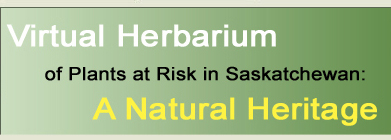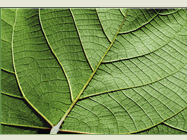|
| Juncus albescens
(Lange) Fern. |
|
| |
| TAXONOMY |
| |
| Family: |
Juncaceae |
| Genus: |
Juncus |
| |
| Species Synonyms: |
Juncus triglumis ssp. albescens
(Lange) Hultén
Juncus triglumis var. albescens
Lange |
| Common Names: |
northern white rush
pale three-flowered rush |
| |
| DISTRIBUTION |
| |
| Canada: |
Yukon Territory – Mackenzie District –
Victoria Island – Baffin Island, south to southeastern British Columbia
– southwestern Alberta – northern Saskatchewan – northeastern
Manitoba – northern Ontario – Ungava – Labrador –
eastern Quebec |
| Saskatchewan: |
northern Saskatchewan; Lake Athabasca –
Hasbala Lake |
| Ecoregion: |
Athabasca Plain, Selwyn Lake Upland |
| |
| HABITAT |
| |
| Saskatchewan: |
muskegs, drainage channels, and tundra boulder
fields |
| Associated Species: |
black spruce, dwarf birch, shrubby cinquefoil |
| |
| RARITY STATUS |
| |
Provincial
Status According
to Harms (2003): |
Endangered |
| Nature Conservancy
Status: |
G5 S1 |
Saskatchewan
Species at
Risk Status: |
None |
| COSEWIC Status:
|
None |
| |
| Northern white rush
is endangered in Saskatchewan because it is rare and regionally restricted
to the northern part of the province. No immediate threats are known at
the present time. |
| |
| SPECIES
DESCRIPTION |
| |
| Height: |
3 – 35 cm |
| Roots: |
rhizomes |
| Stems: |
perennial, stems 1 – 8, tufted, may form
clumps, very slender |
| Leaves: |
basal leaves 2 – 4, blade deeply channelled,
2 – 10 cm long, mostly shorter than stems; ear-like lobes at base
of leaf prolonged, rounded, dry and membranous |
| Inflorescence: |
head solitary, 2 – 3-flowered, terminal;
primary bracts brownish, about equal to the inflorescence, tip awned or
sharply pointed |
| Flowers: |
tepals 3 – 5 mm long, outer and inner series
nearly equal, oblong, pale brown or darker or whitish or pinkish; stamens
6; ovary superior, stigmas 3 |
| Fruits: |
capsules barely longer than perianth, 3 –
5 mm long, tip nearly square, 3-locular, tan; seeds tan or darker, spindle-shaped,
with white tails shorter than the body |
| |
| JUNCUS
KEY FOR SPECIES FOUND IN SASKATCHEWAN |
| |
| 1 Inflorescence appearing lateral;
leaves all basal |
2 |
| 1 Inflorescence appearing terminal;
may have at least one blade-bearing leaf on the lower stem or all leaves
basal |
3 |
| |
|
2 Bract stout, much shorter than stem;
perianth parts usually darker brown; anthers commonly much longer than their
filaments
|
J. balticus |
| 2 Bract slender, as long as or longer
than stem; perianth parts greenish to light brown; anthers commonly shorter
than or equal to their filaments |
J. filiformis |
| |
|
| 3 Leaves divided by cross-partitions,
rounded, or if flattened, bases overlapping and blades appearing oriented
with the edge towards the stem |
4 |
| 3 Leaves not divided by cross-partitions,
rounded or if flattened, not appearing oriented with the edge towards the
stem |
12 |
| |
|
| 4 Leaves strongly flattened and bases
overlapping and blades appearing oriented with the edge towards the stem |
5 |
| 4 Leaves rounded or slightly flattened |
7 |
| |
|
| 5 Styles surpassing petals; seeds
with a distinct tail-like appendage |
J. tracyi |
| 5 Styles equal to petals; seeds without
a tail |
6 |
| |
|
| 6 Stamens 3; ear-like lobes at the
base of the leaf lacking |
J. ensifolius |
| 6 Stamens 6; ear-like lobes at the
base of the leaf present |
J. saximontanus |
| |
|
| 7 Flowers in dense spherical heads |
8 |
| 7 Flowers few to many in narrower
heads |
10 |
| |
|
| 8 Heads solitary; rhizomes densely
matted |
J. mertensianus |
| 8 Heads solitary; rhizomes elongate
and creeping, often bearing swellings |
9 |
| |
|
| 9 Tepals reddish-brown, inner tepals
longer than or equal to outer tepals; leaves 1 – 2 mm thick; sheaths
with yellowish ear-like lobes |
J. nodosus var. nodosus |
| 9 Tepals greenish to dull brown, inner
tepals shorter than outer tepals; leaves to 5 mm thick; sheaths with membranous
ear-like lobes |
J. torreyi |
| |
|
| 10 Seeds about 1 mm long, with definite
white tail-like appendages |
J. brevicaudatus |
| 10 Seeds less than 0.5 mm long, sharply
pointed but without white tails |
11 |
| |
|
| 11 Anthers shorter than or equalling
their filaments; perianth segments obtuse; capsule exceeding the perianth |
J. alpinoarticulatus ssp. nodulosus |
| 11 Anthers distinctly longer than
their filaments; perianth segments acute; capsule shorter than or equal
to the perianth |
J. nevadensis |
| |
|
| 12 Each flower inserted singly on
the branches of the inflorescences and subtended by a pair of small bractlets
in addition to the bractlet at the base of the flower stalk |
13 |
| 12 Each flower subtended only by the
single bractlet at the base of the very short stalk |
19 |
| |
|
| 13 Roots fibrous; dwarf species, branched
near base; annuals; leaf sheaths without ear-like lobes |
J. bufonius |
| 13 Rhizomes elongate or short if stem
densely tufted; plants not dwarfed or branched near the base; perennials;
leaf sheaths with ear-like lobes or prolonged |
14 |
| |
|
| 14 Leaf sheaths extending to about
halfway up the stem |
J. compressus |
| 14 Leaf sheaths confined to base or
only extending to about one third of the way up the stem |
15 |
| |
|
| 15 Sepals erect, closely appressed
to the capsule |
J. vaseyi |
| 15 Sepals spreading to ascending,
not closely appressed to the capsule |
16 |
| |
|
| 16 Ear-like lobes at the base of the
leaf short and round; leaf blades less than half the length of the stem |
J. dudleyi |
| 16 Ear-like lobes at the base of the
leaf delicate and membranous; leaf blades usually greater than half the
length of the stem |
17 |
| |
|
| 17 Capsule 3-loculed, nearly equalling
the perianth; inflorescence compact |
J. confusus |
| 17 Capsule 1-loculed, distinctly shorter
than the perianth; inflorescence a loose, branched inflorescence |
18 |
| |
|
| 18 Ear-like lobes at the base of the
leaf prolonged into a membranous projection 3 – 5 mm long |
J. tenuis |
| 18 Ear-like lobes at the base of the
leaf shorter, up to 2 mm long, nearly membranous |
J. interior |
| |
|
| 19 Seeds with a sharp point; leaves
flattened and grass-like |
J. longistylus |
| 19 Seeds with distinct white tail-like
appendages; leaves rounded to somewhat flattened or deeply channelled |
20 |
| |
|
| 20 Stems arising from elongate rhizomes;
perianth and capsules dark brown to black |
J. castaneus ssp. castaneus |
| 20 Stems not rhizomatous, may form
clumps; perianth and capsules pale |
21 |
| |
|
| 21 Capsules to 9 mm long; heads 1
– 2; lower stem leaves 1 – 3 |
J. stygius ssp. americanus |
| 21 Capsules to 4 mm long; heads solitary;
leaves all basal |
J. albescens |
|






